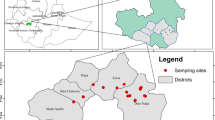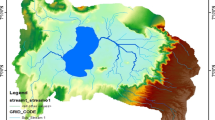Abstract
Lake Tana is the largest freshwater body in Ethiopia, and it is a multi-use water body. However, currently the lake size reduced by different pressures, of these the occurrence of aquatic invasive weeds specifically, water hyacinth (Eichornia crassipes). The study was focused to evaluate the physiology of water hyacinth and its effect on water transpiration and quality in Lake Tana. In addition to water hyacinth, two wetland grasses (Cyperus papyrus and Typha latifolia) were selected based on predominance along the lake shore line. Plant physiology parameters (e.g., leaf width, height, and number of leaves) and transpiration data were collected in every week and day, respectively. In situ field measurements were also taken to observe vegetation treatments response for water quality. The result showed that transpiration of water hyacinth was two times higher than papyrus and T. latifolia. The number of leaves and leaf widths are significantly (p < 0.1) increased in water hyacinth weed compared to the corresponding wetland vegetations. Dissolved oxygen and temperature were statistically significant (p < 0.05) due to water hyacinth compared to the corresponding treatments, and the values were also beyond the desirable standard. Therefore, Lake Tana water alterations due to water hyacinths will be continued where effective controlling mechanisms have not been taken there.


(Image taken July, 2017)


Similar content being viewed by others
References
Asmare E (2017) Current trend of water hyacinth expansion and its consequence on the fisheries around north eastern part of Lake Tana, Ethiopia. J Biodivers Endanger Species 5:189. https://doi.org/10.4172/2332-2543.1000189
Ayalew W, Ali S, Eyayu M, Goraw G, Gkidan W, Agegnehu S, Dereje T, Muluneh G M (2012) Preliminary assessment of water hyacinth (Eichornia crassipes) in Lake Tana. In: Proceedings of national workshop. Biological Society of Ethiopia, Addis Ababa
Balirwa J, Wanda F, Muyodi F (2009) Impacts of water hyacinth and water quality change on beneficial uses of Lake Victoria, Uganda. In: 13th World lake conference. Wuhan, China, 1–5 November 2009
Bhattacharya A, Haldar S, Chatterjee P (2015) Geographical distribution and physiology of water hyacinth (Eichhornia crassipses)—the invasive hydrophyte and abiomass for producing xylitol. Int J Chem Tech Res. 7(4):1849–1861
Crundwell R (1986) A Review of hydrophyte evapotranspiration. Rev Hydrobiol Irop 19(3–4):215–232
Dagnew M, Minwyelet M, Getahun A, Anteneh W (2014) Spawning migration of Labeobarbus species of Lake Tana to Gilgel Abay River and its tributaries, Blue Nile Basin, Ethiopia. Afr J Fish Sci 2(9):176–184
Denny P (1984) Permanent swamp vegetation of the Upper Nile. Hydrobiology 110:79–90
Dersseh MG, Kibret AA, Tilahun SA, Worqlul AW, Moges MA, Dagnew DC, Abebe WB, Melesse AM (2019) Potential of water hyacinth infestation on Lake Tana, Ethiopia: a prediction using a GIS-based multi-criteria technique. Water 11(9):1921
Ewnetu D, Bikes D, Daniel H (2014) Determination of surface water quality status and identifying potential pollution sources of Lake Tana. J Environ Earth Sci 4(13), ISSN 2224-3216
Firehun Y, Struik PC, Lantinga EA, Taye T (2014) Water hyacinth in the Rift Valley water bodies of Ethiopia: its distribution, socio-economic importance and management. Int J Curr Agric Res 3(5):67–75
Gopal B (1987) Aquatic plant studies, water hyacinth. Elsevier, Amsterdam, The Netherlands
Goraw G (2012) Wetlands for sustainable development and climate change mitigation. In: Seyoum M, Tadesse F (eds) 2nd National workshop, Bahir Dar, January 2012. Water quality deterioration as potential enabling environment for proliferation of floating water hyacinth (E. crassipes) in NW-river mouths of Lake Tana. pp 162–190
Goraw G, Shimelis A (2017) Problem overview of the Lake Tana Basin. AESS Interdisciplinary Environmental Studies and Sciences Series. Springer, Berlin. https://doi.org/10.1007/978-3-319-45755-0_2
Kelly A, Linda G (1997) Dissolved oxygen and temperature. Natural resource facts. University of Rhode Island, College of Resource Development Department of Natural Resources Science, Fact Sheet No. 96-3
Kumar A, Yang T, Sharma MP (2019) Long-term prediction of greenhouse gas risk to the Chinese hydropower reservoirs. Sci Total Environ 646:300–308
Ndimele P, Kumolu-Johnson C, Anetekhai M (2011) The invasive aquatic macrophyte, water hyacinth [Eichornia crassipes (Mart.) Solm-Laubach: Pontedericeae]: problems and prospects. Res J Environ Sci 5:509–520
Ogwang JA, Molo R (2004) Threat of water hyacinth resurgence after a successful biological control. Biocontrol Sci Technol 14(6):623–626
Paulo C, Mariam D, Luiz R (2006) The ratio of water hyacinth evapotranspiration to open water evaporation as influenced by weather conditions, leaf area and aerodynamics. Rev Bras Agrometeorol 14(3):336–346
Rezene F (2012) Status of water hyacinth (Eichornia crassipes) in Ethiopia: challenges and response. In: Tefera B, Worie W, Wale M (eds) Proceedings of the second national workshop on challenges and opportunities of water resources management in Tana Basin, Upper Blue Nile Basin, Ethiopia, 26–27 March 2012. Blue Nile Water Institute—Bahir Dar University (BNWI-BDU), Bahir Dar, Ethiopia, pp 159–166
Solomon K (2017) Ethiopian’s Lake Tana is losing the fight to water hyacinth. Elsevier, Amsterdam, The Netherlands
Tewabe D (2015) Preliminary survey of water hyacinth in Lake Tana, Ethiopia. Glob J Allergy 1(1):103
Tewabe D, Asmare E, Zelalem W, Mohamed B (2017) Identification of impacts, some biology of water hyacinth (Eichornia crassipes) and its management options in Lake Tana, Ethiopia. Net J Agric Sci 5(1):8–15
UNEP (2013) Water hyacinth—Can its aggressive invasion be controlled? http://www.unep.org/…/UNEP_GEA. Accessed 04 June 2018
Van Kleunen M, Weber E, Fischer M (2010) A meta-analysis of trait differences between invasive and non-invasive plant species. Ecol Lett 13(2):235–245. https://doi.org/10.1111/j.1461-0248.2009.01418.x
Victor H, Rafael A, Maria D (1987) Evapotranspiration from Eichornia crassipes, Pistia stratiotes, Salvinia herzogii and Azolla caroliliana during a summer period (Paraná, Argentina). J Aquat Plant Manag 25:48–50
Wassie A, Dereje T, Addisalem A, Abebaw Z, Befta T, Yitayew W (2015) Water hyacinth coverage survey report on Lake Tana Biosphere Reserve, Technical Report Series 2
Yihun D, Wondwossen T (2017) Analysis: Lake Tana: How an invasive weed is threating its survival. For Addis standard
Acknowledgements
The authors wish to thank the University of Gondar for their financial and operational support to conduct this research.
Author information
Authors and Affiliations
Corresponding author
Ethics declarations
Conflict of interest
The authors declare that they have no competing interests.
Additional information
Publisher's Note
Springer Nature remains neutral with regard to jurisdictional claims in published maps and institutional affiliations.
Rights and permissions
About this article
Cite this article
Muche, H., Mucheye, T. & Tadesse, D. Water quality and transpiration responses of Eichornia crassipes at Lake Tana, Ethiopia. Sustain. Water Resour. Manag. 6, 42 (2020). https://doi.org/10.1007/s40899-020-00392-w
Received:
Accepted:
Published:
DOI: https://doi.org/10.1007/s40899-020-00392-w




